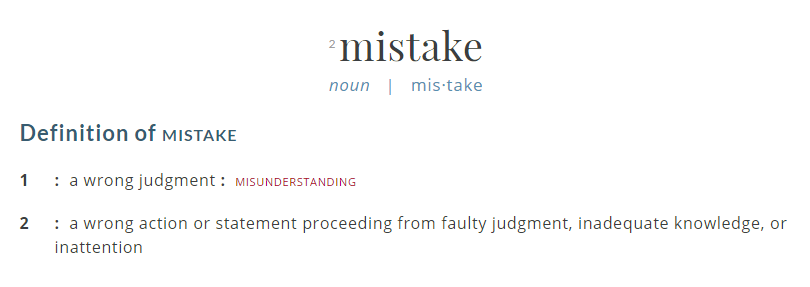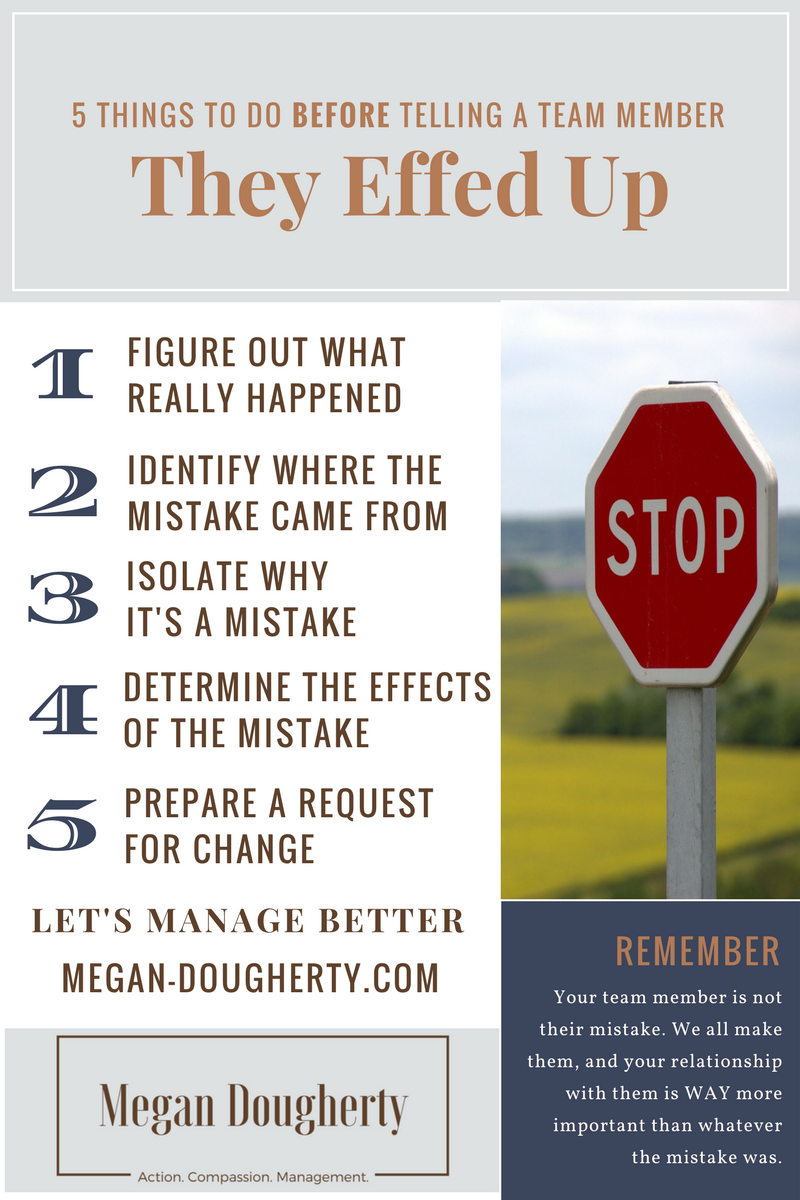All managers have to give feedback to employees or other sorts of team members from time to time – it’s part of the gig.
There are a number of different ways feedback should be delivered, and ideally, most of it will come in planned and prepared for evaluation sessions.
Sometimes, however, someone effs up and it needs to be addressed immediately.
Or almost immediately.
When a team member (or contractor or freelancer) screws something up, it needs to be addressed, and depending on the severity of the error, corrective action might need to be taken. Either way, the impulse is going to be to talk to them right away to get things sorted out.
But jumping right into that conversation without any forethought can cause even bigger problems down the road.
The person who screwed up is probably not in a great headspace at the moment (or they don’t realise there was a mistake yet) and the wrong handling of this situation could permanently sour your relationship, which will cost you SO much more in the long term.
If you don’t have to fire them (that’s another kettle of fish entirely) there are 5 things you should do before addressing the issue with your team member.
Figure Out What REALLY Happened
Right now, all you know is that a mistake happened, and that is not enough information to go into a conversation with the person who made it.
Look at the chain of events as you understand them, particularly:
- What was SUPPOSED to happen?
- What has happened in the past?
- What else was happening at the same time?
For example, if your content marketer sent out an email with [NAME] in the email instead of people’s actual names, you can determine that:
- The personalization tag was supposed to be the first name one.
- Usually, that personalization tag is applied to emails.
- Other things going on at the company at the moment are a mid-size product launch, and onboarding a new graphic designer, as well as the usual day-to-day operations.
To look at something a little more complex, let’s say the error was that your team member misquoted the rate of services to several new leads, and they are all expecting to get a MUCH lower rate than you currently offer.
- The team member should have quoted the correct (higher) rates for the services.
- In the past, rates were decided on a custom basis by the sales manager, who has been training the team member to take over with standard rates.
- Responsibilities are shifting as the company grows, and people are taking on new roles and learning new skills.
This kind of thinking is important because you need to put the mistake in the context of what is going on more globally. Mistakes are sometimes isolated incidents, but more often connected to other things that are happening or have happened.
Now, you won’t likely know the whole story yet, so if there are other team members or managers that you need to consult, do so. But do so subtly. This is not the time for a company-wide email, but rather a quiet, neutral conversation to learn the details of the situation.
It’s absolutely acceptable to speak to the team member who made the mistake in two parts: information-gathering, and feedback-giving. Just make sure they are aware of what is happening, and what is going to happen afterwards.
Identify Where The Mistake CAME From
So how did a mistake like this even happen? From where you’re sitting, it’s totally unacceptable. Your team should know how to do their jobs, and there are checks and balances to make sure these kinds of things don’t happen.
But is that really true? Is your company set up such that no one will ever make a mistake ever?
Not likely. In fact, not possible.
Mistakes are going to happen, and in most cases, a mistake is really an opportunity to learn about something that can be changed or improved. And that starts by looking at the source of the mistake. Mistakes don’t drop out of the sky or materialise out of the ether (usually,) – they always come from SOMEWHERE, so finding the source of a particular mistake is critical to making sure it doesn’t happen again.
Some of the most common mistake sources are:
Excessive busyness. When we’re rushed and under pressure, it’s easy to skip steps!
Bad training or documentation. If your team member made a mistake based on information that was incorrect or out of date, that needs to be fixed.
Mixed Messages. If multiple people told your team member different things then they’re going to have picked one and gone ahead with it.
Over Reaching. If the team member is new to the role where they made the mistake, maybe they aren’t really ready, and the work was too far out of their zone of awesome.
Simple human error. Sometimes people forget things, or spell stuff wrong, or remember old procedures before new ones, or get angry.
As you can see from this list, some mistakes are much more serious than others, and all are going to require different types of solutions – some from the team member’s end of things, and some from yours. If you determine that this mistake came from a simple human error, you can usually skip step 4 – and jump right into thinking about behaviour or process changes.
Isolate WHY It’s A Mistake
This one is the most challenging, but also the most important, for situations where the source of the mistake was not simple. This is where you start to consider what kind of problem it is you’re really trying to solve. You might unearth a problem with your management strategies, the fit of the team member in the role, your communication or the systems and procedures you use to get things done, among others.
This is different from the source of the mistake because it has less to do with the chain of events and nitty-gritty details and more to do with the question of ‘Is what we’re doing working?’ and that is a question you should be asking yourself more or less constantly.
To do this, we first have to understand what a mistake (or a fuck up) really is.
(Thanks Merriam-Webster! Keep Tweeting forever, please.)
Looking at it this way, effing up means making the wrong decision, or taking the wrong action in word or deed.
So look at the mistake that you have to address. Was it that they made a bad decision, or that they took action that was based on being ill-informed or not paying attention?
Plainly each of these needs a different reaction from you, as the manager.
Making a bad decision means they probably need more training or understanding of what the overall goals of their role are.
Doing the wrong thing because they are ill-informed means that you need to tighten up your communication and documentation.
Doing the wrong thing because they weren’t paying attention means you need to look at the procedure they are using, see if they are too busy, or request they work on that skill.
These aren’t the ONLY possibilities of course – but the vast majority of mistakes fit into these categories (plus simple human error) so you can plan the changes that need to be made and talked about when you’re giving feedback from a position of knowledge and confidence.
Determine The EFFECTS of the Mistake
Now that your brain hurts, you have to start thinking about what is going to happen as a result of this error.
Are you looking at a mob of angry customers? Confusion within the team? Lost revenue? Public embarrassment?
It’s important to know what you think is going to happen, because in many cases, the person who made the mistake won’t understand why it was a mistake, or why it was a big deal.
Even when they DO know why it was a bad screw up, you need to provide the context for the feedback you are giving. A common failure of management is to assume that what WE know and prioritise is the same thing our employees or team members will know and prioritise. Unless you tell someone, they don’t know, and what seems obvious to you might never have occurred to someone else.
A long, drawn-out discussion about something that seems irrelevant to your team member is going to cause frustration and resentment, but a few moments explaining the broader context of the discussion can make a huge difference.
The full effects of the mistake are also important for deciding what change you’ll need to see after you give the feedback. If the effects of the mistakes are minor, a few people were slightly inconvenienced, you don’t need to ask for much change – maybe to send an extra test, or take a quick tutorial on the email platform.
If the effects are bigger, like setting bad price expectations for a lot of leads (and their friends and referrals), you need to ask for a bigger change – and to justify that bigger change, you need to be very clear about what the outcomes of the error were.
Prepare a Request for CHANGE
Now that you’ve figured out what happened, where it came from, why it (to the best of your knowledge) happened, and what the effects will be, you have to decide what you need your team member to DO about it.
Depending on the source and type of mistake we’re talking about, ‘change’ could mean any number of things, but usually involves two elements: a correction and a prevention for the future.
Going back to our examples again, if the mistake is a simple one, like mixing up email settings, those two things might look like:
- Send an apology email, and
- Make sure to send a test email to yourself and one other person before sending.
Because the error was a simple human one, with a dash of role-change and new technology going on, you don’t need to read the riot act or make a big deal out of things. You need to make sure the people who received the email get an apology, and you need to make sure there’s a more robust proofreading or testing process going forward.
Now when you go into the “mistake” conversation, you have some firm things to ask your team member to do. They are going to like this because it’s a way for them to fix their mistake, and to prevent it from happening again.
In more complex situations, the changes you need to request will be bigger and impact more people. In our misquoting example, the two elements are both bigger deals.
The correction might be reaching out to the leads, explaining there was an error, and bringing in a more senior salesperson.
The prevention might be going back to training, updating documentation and learning materials, or even stepping away from the role for a time, or working more in research, lead-gen or follow-up for a while.
Whatever the changes are going to be, you want to go in with at pretty good idea of what needs to happen. Your employee might have ideas of their own on how to correct the mistake and prevent it from happening again, but as the manager, you should come ready with solutions to discuss.
Providing feedback in a way that maintains safety is a challenge, and often you’ll be talking to people who are anxious, defensive, or otherwise upset.
This is why you want to have specific, actionable things you need them to do, and specific actionable things that you will do. It’s not knowing that causes an environment of fear, and that is an environment that will lead to unhappy, unproductive team members, high turnover and lower profits.
Probably the most important thing for you to remember is that your team member is not their mistake. Even if it was a big, hairy ‘going-to-take-forever-to-fix’ mistake – it’s not the end of the world, and for the vast majority of companies, no one’s going to lose a leg, and it’s all going to be fine.
Bonus: If there are multiple members of a management team, for the love of paid time off, make sure only one person talks to them about it. Getting jackhammered by multiple people with feedback about the same issue is both a waste of time, and creates a hostile environment. One person delivers the news. That’s it.
Want to Remember these steps? I made you a graphic! Feel free to print it out, pass it along or otherwise share it, but please, link back to this blog post.
What do you think of this process? How do you handle team members making mistakes?
Let me know in the comments, and let’s talk.




Great article!
I especially love the bonus part. Over-management by a team has always been a pet peeve of mine. It raises frustration levels, wastes both our time, and can often result in mixed messages.
Thanks Brittany! I agree wholeheartedly – especially around difficult or sensitive areas, more messengers = more problems.
Great advice, Megan. It’s all about balance, perspective and respect.
I love your approach, Megan. It’s more proactive than finding a Fall Guy to take the blame and ruin team relationships.